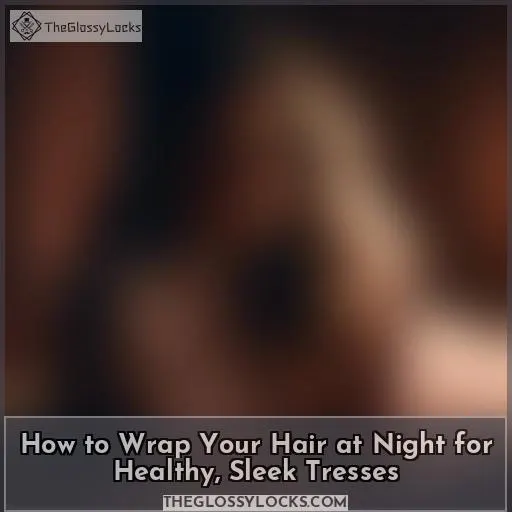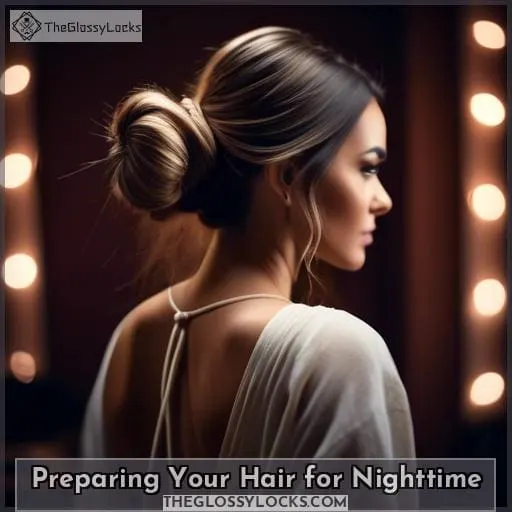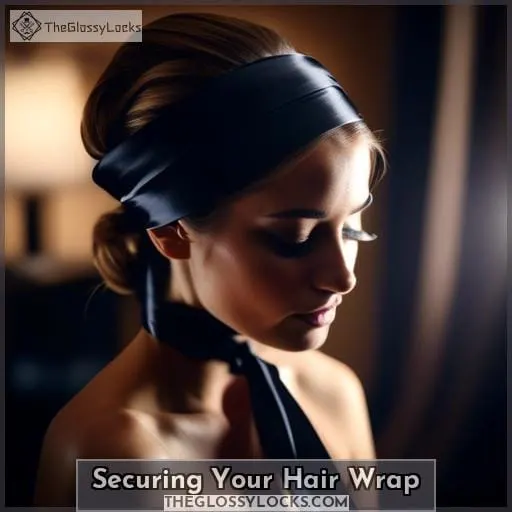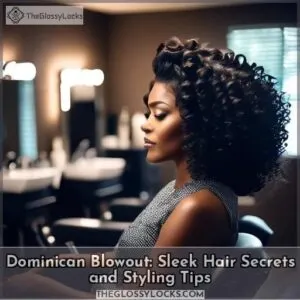This site is supported by our readers. We may earn a commission, at no cost to you, if you purchase through links.
 Transform your nightly routine into a luxurious hair spa with the simple act of wrapping your hair.
Transform your nightly routine into a luxurious hair spa with the simple act of wrapping your hair.
This age-old secret, a whisper of silk or satin against your strands, can be the difference between waking up to a frizzled mess and unveiling sleek, healthy tresses.
Whether you’re preserving a perfect blowout or nurturing natural curls, learn how to wrap your hair at night and join the ranks of those who wake up to effortlessly beautiful hair.
Yes, to wrap your hair at night, start by parting it and pinning up sections, then use a silk or satin scarf to create a head wrap, securing it at the nape of your neck. This method helps maintain sleek, straight hair and prevents frizz, tangles, and breakage while you sleep.
Table Of Contents
- Key Takeaways
- Preparing Your Hair for Nighttime
- Securing Your Hair Wrap
- Maintaining Hair Health While You Sleep
- Frequently Asked Questions (FAQs)
- Can hair wrapping contribute to hair loss or thinning in certain areas of the scalp?
- Are there any specific hair types or textures that should avoid wrapping their hair at night?
- How can I prevent the elastic of my bonnet from leaving marks on my forehead or causing headaches?
- If I have a sensitive scalp, are there any materials or techniques I should avoid when wrapping my hair?
- What are some signs that I might be wrapping my hair too tightly and risking damage?
- Conclusion
Key Takeaways
- Use a wide-tooth comb or fingers for detangling, starting from the ends, and apply a leave-in conditioner or hair oil to maintain moisture.
- Opt for silk or high-quality satin (like charmeuse satin) materials for hair wraps to reduce friction, prevent breakage, and retain moisture.
- Secure hair loosely with satin or silk scarves, bonnets, or snap-on rollers to avoid thinning or breakage while maintaining style and moisture.
- Maintain hair health by avoiding tight hairstyles and harsh materials, and consider using adjustable bonnets or satin scarves tied for comfort to prevent headaches or marks from bonnet elastics.
Preparing Your Hair for Nighttime
To ensure your hair remains healthy and sleek overnight, it’s crucial to detangle and moisturize before bed.
Opt for a hair wrap made of gentle materials like satin or silk to minimize friction and maintain moisture.
This simple routine can make a significant difference in the health and appearance of your tresses.
Detangling and Moisturizing
- Detangling routines are your best friend. Gently work through those curls with a wide-tooth comb or your fingers, starting from the ends and moving upwards. It’s like solving a puzzle with patience and care.
- Moisture application techniques can make or break your hair’s health. Apply a leave-in conditioner or hair oil to keep those strands hydrated. It’s like giving your hair a nice, big drink before bed.
- Choosing the right hair wrap materials is crucial. Opt for a silk pillowcase or silk hair wrap to reduce friction and prevent moisture loss. It’s like choosing the perfect silk pajamas for your hair!
- Scalp care shouldn’t be neglected. A light scalp massage with oil can stimulate blood flow and promote hair growth. It’s like a spa day for your scalp!
By incorporating these steps into your nightly routine, you’re not just preparing your hair for a night of rest; you’re setting the stage for healthier, happier curls. It’s all about treating your hair with the love and respect it deserves, ensuring it wakes up feeling refreshed and rejuvenated, just like you.
Choosing the Right Hair Wrap Material
Choosing the right hair wrap material is crucial for maintaining healthy, sleek tresses while you sleep. The battle between silk and satin is a common dilemma, but understanding their differences can guide you to the best choice for your hair.
Silk, a natural protein fiber, is known for its strength, breathability, and luxurious softness. It’s derived from the cocoons of silkworms, making it a more expensive option due to its labor-intensive production process.
Satin, on the other hand, is a weave that can be made from various fibers, including silk, polyester, nylon, or rayon. It’s characterized by its glossy surface and offers a similar smoothness and moisture retention to silk, but at a more affordable price point.
When it comes to hair care, both materials are celebrated for their gentle hold on the hair, reducing friction and preventing breakage and frizz. However, if you’re seeking the utmost in moisture retention and natural benefits, mulberry silk is unparalleled.
Its natural properties help maintain the hair’s hydration, contributing to healthier, shinier locks. For those on a budget or looking for a vegan option, high-quality satin, especially charmeuse satin, can be an effective alternative, providing many of the same benefits as silk, such as reduced friction and moisture preservation, without the higher cost or use of animal products.
Ultimately, the choice between silk vs satin boils down to personal preferences, including considerations of cost vs effectiveness, synthetic vs natural fibers, and comfort vs style. Regardless of your choice, incorporating either of these materials into your nighttime hair care routine can lead to noticeable improvements in your hair’s health and appearance.
Securing Your Hair Wrap
To secure your hair wrap at night, it’s essential to choose the right materials and techniques that suit your hair type and length.
Satin or silk scarves and bonnets are excellent choices for reducing friction and maintaining moisture, which can lead to healthier hair.
Snap-on rollers offer a no-heat method to achieve curls while you sleep.
When wrapping your hair, ensure it’s not too tight to avoid potential thinning or breakage.
Using Satin or Silk Scarves
When it comes to wrapping your hair at night, choosing between satin and silk scarves is like deciding between a cozy blanket and a luxurious quilt. Both have their charm, but it’s the subtle differences that make your choice personal.
Imagine wrapping your tresses in a satin scarf, its smooth surface gliding over your hair, minimizing friction and keeping those locks in check without sucking the life out of them. Satin, being minimally absorbent, acts like a gentle guardian, preserving your hair’s natural moisture and keeping it just as lively as you left it.
On the flip side, silk whispers luxury. It’s the fabric that dances to the tune of opulence, offering breathability and a natural softness that’s hard to match. Silk’s natural proteins can pamper your hair, providing a smooth surface that reduces breakage and maintains your hair’s natural shine.
But remember, with great luxury comes great responsibility. Silk might require a bit more care than its synthetic counterpart, satin, which is easier to maintain and kinder to your wallet.
So, whether you’re team satin or silk, remember it’s all about keeping those curls cuddled and protected. Think of your satin or silk scarf as your hair’s best friend, one that whispers sweet nothings to your locks at night, ensuring they wake up just as refreshed as you do.
And if you’re ever in doubt, why not flirt with both? After all, variety is the spice of life, and your hair deserves all the pampering it can get.
Tips for Using Bonnets and Snap-on Rollers
When it comes to securing your hair at night, bonnets and snap-on rollers can be your best friends. Opt for bonnets made from satin or silk to ensure breathability and retain moisture, which is crucial for protecting curly hair and reducing dryness.
The fit of the bonnet is also important; it should be snug but not too tight to avoid leaving marks on your forehead or causing headaches. As for rollers, choose types and sizes that match your desired outcome—smaller rollers for tighter curls and larger ones for looser waves.
Maintaining Hair Health While You Sleep
To maintain the health of your hair while you sleep, consider the benefits of silk and satin. These materials can be game-changers for your nighttime routine. They help reduce friction and breakage, preserving your hairstyle and keeping your locks smooth.
If traditional hair wraps aren’t your style, there are plenty of alternatives and styling tips to keep your tresses sleek and healthy post-wrap.
Benefits of Silk and Satin
When it comes to maintaining your hair’s health while you sleep, the debate of silk vs satin is like comparing apples to oranges—both have their unique benefits. Silk, a natural protein-based fiber, is hypoallergenic and gentle on your hair, reducing friction and frizz, and preventing moisture loss.
On the other hand, satin, with its minimally absorbent nature, ensures your hair’s moisture levels stay balanced, so you wake up with hydrated, happy curls. It’s the unsung hero of hair care, providing a vegan and cruelty-free option that’s kind to both your curls and your wallet.
Plus, satin is easy to care for, so you can spend less time on laundry and more on loving your locks.
Whether you choose a silk pillowcase or a satin bonnet, you’re making a smart move for your hair’s health. These materials act like a soft, protective cocoon, safeguarding your hair from the rough-and-tumble world of cotton sheets and pillowcases.
So, wrap your hair in the luxury it deserves and let silk or satin work their overnight magic, keeping your hair damage-free and ready to shine at dawn.
Alternatives to Traditional Hair Wraps
If you’re looking to keep your hair healthy and sleek while you sleep, wrapping it up at night is a tried-and-true method. But if traditional hair wraps feel a bit too last season for you, there are plenty of chic alternatives to keep your locks luscious.
- Preconditioning scarfs can be a game-changer, giving your hair an overnight spa treatment.
- A silk headband not only keeps your hair back but also protects those delicate strands from breakage.
- And for those who love a good DIY moment, Bantu knots offer heatless curls with a side of cultural flair.
Styling Tips for Post-wrap Hair
After wrapping your hair at night, you’ll want to ensure your morning routine amplifies the benefits of your nighttime care.
When you unravel your hair, it’s like unwrapping a present; you’re eager to see the fruits of your preservation efforts. To maintain volume and keep those curls bouncy, flip your head over and give your roots a gentle shake.
If you notice any frizz, a light spritz of water or a touch of leave-in conditioner can help smooth things out. Remember, your hair is like a delicate fabric; treat it kindly to prevent damage.
For those washday results to last, avoid heavy-handed heat styling. Instead, opt for minimal touch-ups with a diffuser or a quick pass of a flat iron on low heat, if necessary. Keep your hair routine simple and efficient to minimize breakage and keep those locks looking lush.
Frequently Asked Questions (FAQs)
Can hair wrapping contribute to hair loss or thinning in certain areas of the scalp?
Yes, hair wrapping can contribute to hair loss or thinning if done too tightly or in the same direction consistently. This practice may cause tension and stress on the hair follicles, leading to traction alopecia.
Are there any specific hair types or textures that should avoid wrapping their hair at night?
While hair wrapping at night is a universal method to protect and maintain healthy hair across various hair types, individuals with very fine or fragile hair should proceed with caution. Wrapping too tightly can lead to tension and breakage, especially if the hair is already prone to damage.
It’s crucial to wrap the hair loosely and use soft materials like silk or satin to minimize friction and avoid any undue stress on the hair follicles. If you notice any discomfort, thinning, or breakage, it might be wise to adjust your technique or explore alternative protective styles that don’t require wrapping.
Always listen to your hair’s needs and adapt your nighttime routine accordingly to ensure your locks stay healthy and vibrant.
How can I prevent the elastic of my bonnet from leaving marks on my forehead or causing headaches?
To avoid the dreaded bonnet imprint saga, opt for an adjustable bonnet.
Alternatively, tie a satin scarf to your comfort.
If I have a sensitive scalp, are there any materials or techniques I should avoid when wrapping my hair?
If you have a sensitive scalp, avoid tight hairstyles and harsh materials.
Opt for gentle, non-irritating fabrics like silk or satin and loose hair wraps to prevent discomfort.
What are some signs that I might be wrapping my hair too tightly and risking damage?
Like a drum pulled too tight, if your head feels like it’s throbbing to a painful beat, you’re likely wrapping your hair too snugly.
Watch for headaches, indentations on your forehead, or a pulsing sensation around your hairline—these are red flags signaling it’s time to loosen up.
Conclusion
Wrapping your hair at night is like tucking your tresses into a silk cocoon; it’s a small step that can spin a big change in your hair’s health and appearance.
By now, you’ve learned the ropes: detangle, moisturize, choose the right wrap, and secure it snugly. Embrace the silky embrace of a hair wrap and let it work its magic, turning potential bedhead into a crowning glory by morning.






